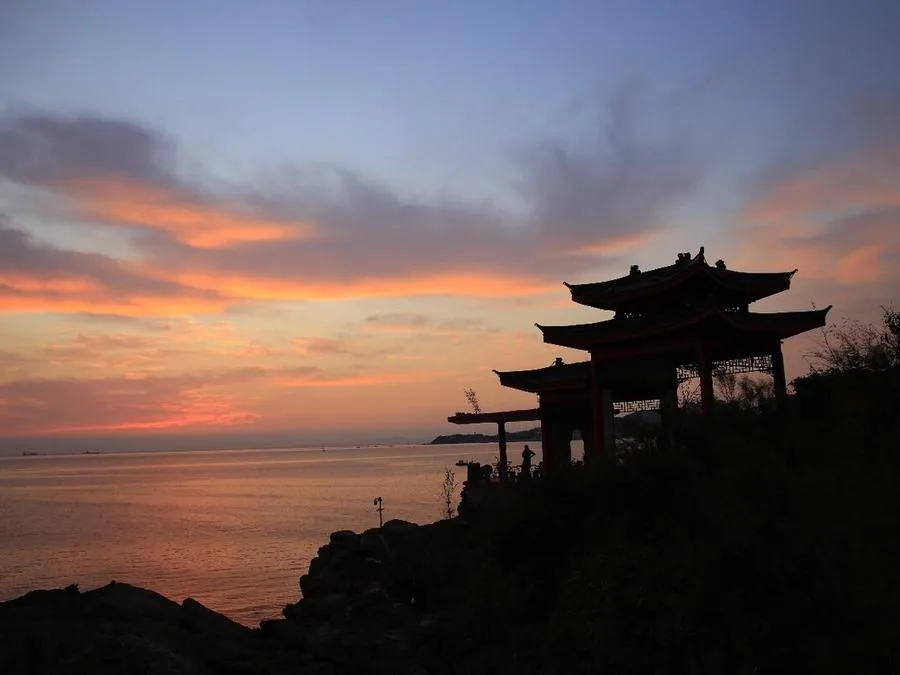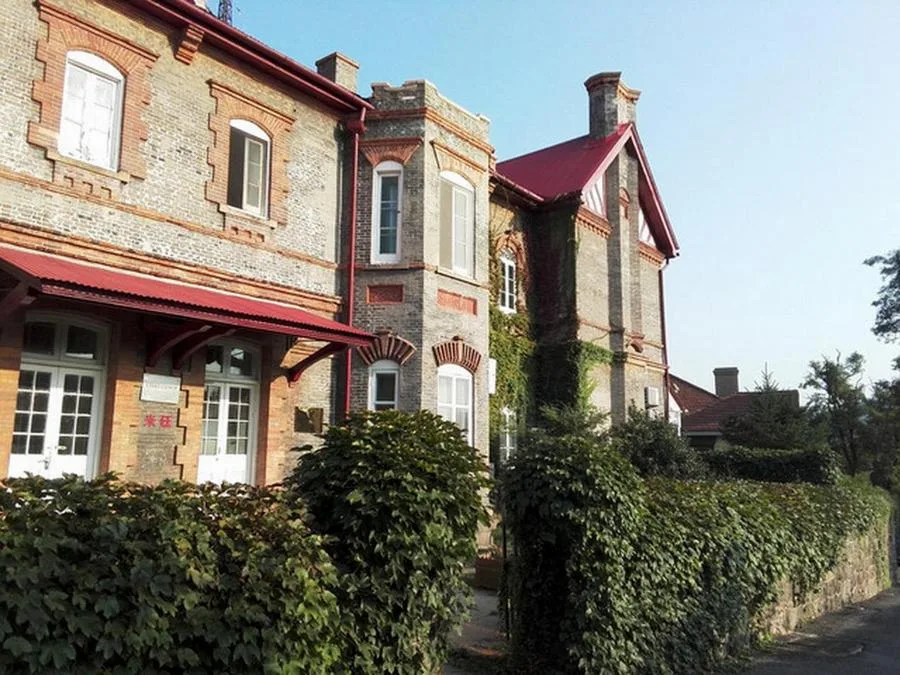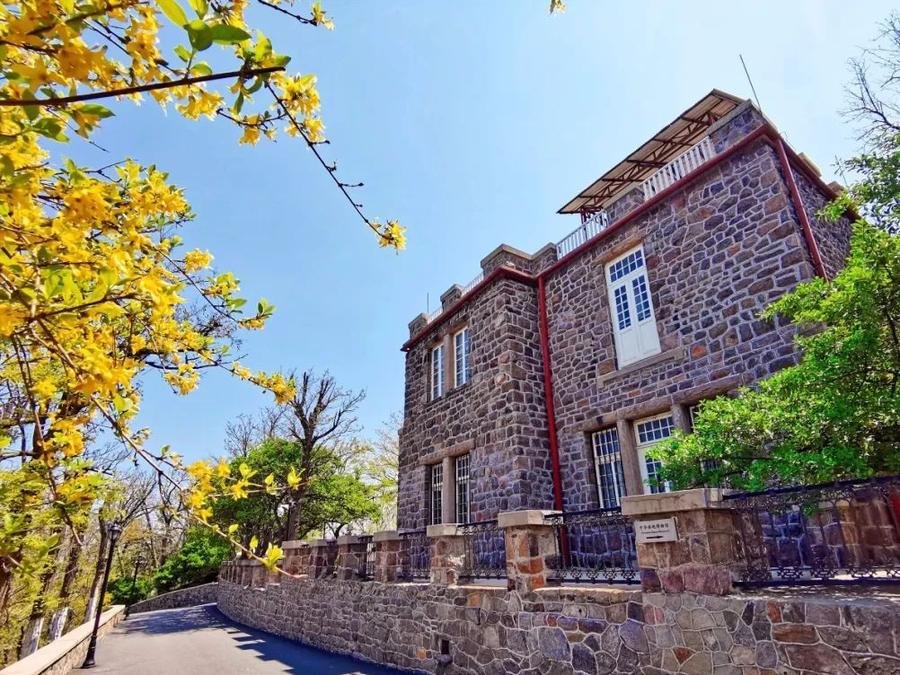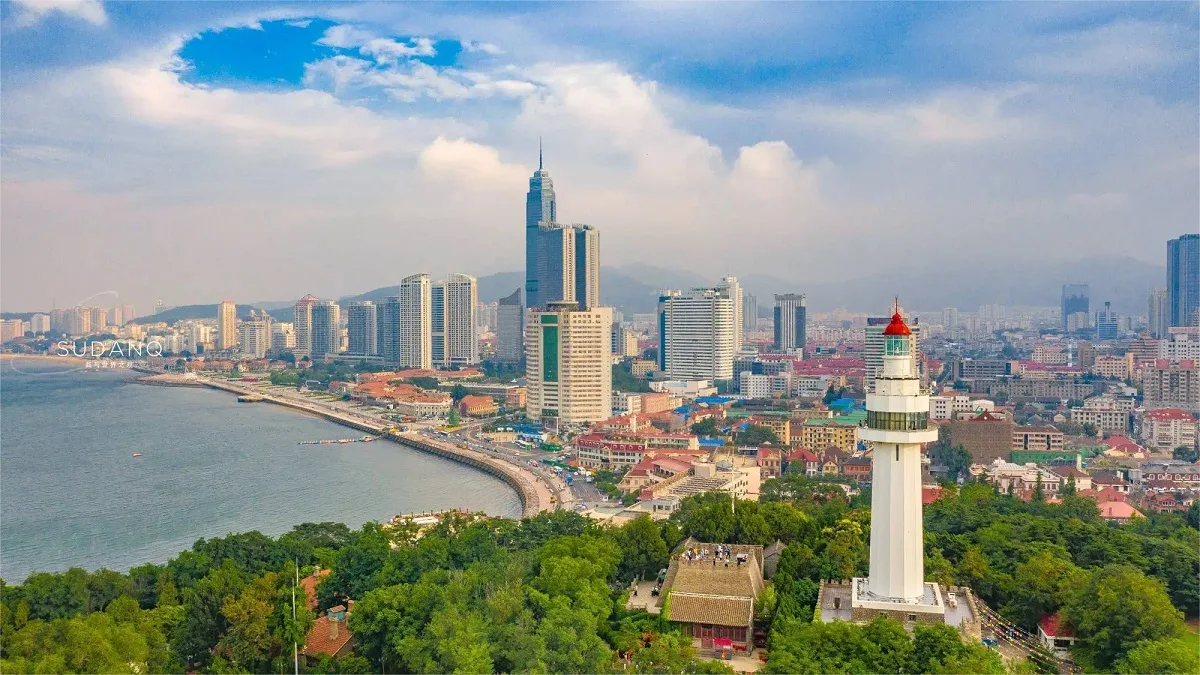Yantai Hill Park (烟台山公园, Yantai Hill Scenic Area) is a landmark scenic area in Yantai, covering 45 hectares and surrounded by the sea on three sides. This park integrates the mountain, sea, city, and port, encapsulating over 600 years of Yantai’s rich history. Within and around the park are numerous consulates, foreign firms, and villas, forming the most well-preserved and densely packed cluster of modern foreign consulates in Asia.
At the top of the hill stands a lighthouse, the highest point in Yantai. Visitors can take an elevator inside the lighthouse to the 11th-floor observation deck, where they can enjoy panoramic views of the sea, coastline, and cityscape. Below the lighthouse is a beacon tower where live performances are held, featuring actors dressed in Ming Dynasty costumes who recreate the lighting of signal fires.
In 1862, Yantai became the first open trading port in Shandong, attracting 17 countries to establish consulates there. On Yantai Hill, six countries—Britain, the United States, France, Germany, Japan, and Denmark—built over 30 modern foreign buildings, including consulates, villas, and official residences. Below the hill, Chaoyang Street, the earliest commercial street after Yantai opened up, retains many historic buildings such as foreign firms and hotels. Notably, the street features the Klicz Hotel, where Sun Yat-sen stayed in the 1920s, the East Customs House, one of China’s earliest customs houses, and an early 20th-century bowling alley, one of the oldest in Asia.
Yantai Hill Park offers a unique blend of natural beauty and historical architecture, making it a significant cultural and historical site that reflects Yantai’s past as a bustling port city and its interactions with foreign nations.
Table of Contents
- Basic Information
- Location and Transportation
- Cultural Attractions of Yantai Hill Park
- Foreign Consulates in Yantai Hill Park
- Vlog about Yantai Hill Park
- History of Yantai Hill Park
- Other Attractions in Yantai Urban Area
Basic Information
| Estimated Length of Tour | 2 hours |
| Ticket Price | The park is free. You need to pay 10 RMB to ascend the lighthouse |
| Opening Hours | 8.00 – 17.30; Last admission: 17.00 |
| Highlights of the Park | Yantai Hill Lighthouse, Relang Pavilion, Bingxin Memorial Hall, and Foreign Consulates |
| Telephone Number | 0086-0535-6632897 |
Location and Transportation
Yantai Hill is located at 7 Lixin Road, Zhifu District, Yantai City, Shandong Province, at the northern end of downtown Yantai. To get there, you can take bus 32, 43, or 46 and get off at Yantai Hill Stop (烟台山站).
Cultural Attractions of Yantai Hill Park
Longwang Temple and Martyrs’ Shrine

Longwang Temple (龙王庙, Dragon King Temple), originally built during the Ming Dynasty, was constructed by the locals to pray for rain and good harvests. The temple has a history spanning several centuries. In 1936, local officials, merchants, and residents pooled resources to restore the temple. During this restoration, a dilapidated house in the temple’s south courtyard was converted into the Martyrs’ Shrine (忠烈祠). The shrine faces south and comprises a main hall, east and west wing rooms, and a gate, forming a closed courtyard.
The main hall houses statues of Guan Yu, a famous general from the Three Kingdoms period, and Yue Fei, a renowned general from the Song Dynasty. On the east side, statues of Guan Ping and Zhou Cang are enshrined, while on the west side, statues of Yue Fei and Zhang Xian are present. Guan Yu’s legacy includes the saying, “Jade can be shattered but cannot be altered in its whiteness; bamboo can be burned but cannot be destroyed in its joint,” symbolizing integrity and resilience. Yue Fei’s famous words, “Sacrifice after sacrifice, reclaim our rivers and mountains,” echo his patriotism and determination.
Bingxin Memorial Hall

The Bingxin Memorial Hall (冰心纪念馆) is located in the former residence of the chief inspector of the East Customs House. It is now open to the public as a tribute to Bingxin, a prominent 20th-century Chinese literary master, a dedicated patriot, and a renowned social activist. Bingxin made significant contributions to cultural exchange and the advancement of women’s and children’s causes.
Her connection to Yantai is profound, as she lived there with her parents from 1903 to 1911, spending her childhood in the city. Bingxin fondly referred to Yantai as her “spiritual hometown,” often expressing deep affection and nostalgia for the city. Her words, “Whenever Yantai is mentioned, memories and feelings surge from all directions.”
The memorial hall showcases Bingxin’s manuscripts, works, photographs, and personal items, highlighting her deep bond with Yantai. It serves as a testament to her legacy and contributions to Chinese literature and society, making it an invaluable cultural resource and intangible asset for Yantai.
Relang Pavilion

Relang Pavilion (惹浪亭) stands elegantly among the rocks where waves crash, showcasing an architectural style that blends ancient and modern elements. Its design is intricate and distinctive, making it appear from a distance either as a floating painting boat or as an ethereal pavilion amidst mist and clouds. The name “Relang Pavilion” translates to “Pavilion that flirts with waves,” reflecting its intimate connection with the sea.
Visitors to Relang Pavilion can enjoy stunning views of the nearby sea and distant mountains. The pavilion is renowned as one of the best spots to watch the sunrise. As the morning fog gradually lifts, the horizon becomes distinct, and the sun’s rosy rays suddenly burst forth from the solar chromosphere, resembling soaring flames. Initially, a curved light band appears, gradually expanding until the sky and sea are bathed in a dazzling orange-red hue. Additionally, Relang Pavilion is famous for being an ideal location to witness the rare phenomenon of a mirage.
Beacon Tower

The Beacon Tower, or “Fenghuotai (烽火台),” has significant historical importance. Emperor Zhu Yuanzhang, the founder of the Ming Dynasty, prioritized national defense and established a comprehensive defense system across strategic locations, including coastal areas. This system comprised garrisons, camps, and fortresses with a layered defense mechanism. The coastal defense during the Ming Dynasty included naval patrols and a coastal warning system with troops stationed along the coast, ready to mobilize.
The Beacon Tower was an integral part of this early warning system. In the early Ming Dynasty, a defensive post was established south of Yantai Hill. In 1398, during the Hongwu period, a beacon tower, also known as “Wolf Smoke Tower,” was built on Yantai Hill, using wolf dung as fuel. When enemy forces approached, smoke signals were sent during the day and fires were lit at night to alert neighboring towers. This system of communication earned the tower its name, and the hill itself was named “Yantai Hill (Smoke Platform Hill),” giving the city of Yantai its name.
Yantai Hill Lighthouse

The Yantai Hill Lighthouse (烟台山灯塔) is the only landmark building in Yantai, constructed in April 1988. This large navigational lighthouse is situated on the coastal hilltop of Yantai Port, guiding ships in and out of the harbor. However, it is not the first lighthouse built on Yantai Hill. The original lighthouse was constructed by the British in 1905 during the 31st year of the Guangxu Emperor’s reign in the Qing Dynasty. Due to deterioration and reduced illumination, it was decommissioned and dismantled in the early 1980s. The current lighthouse was designed by Tsinghua University and serves multiple purposes, including navigation, tourism, and maritime traffic control.
The lighthouse stands 49.5 meters tall and consists of 12 floors. The bottom three floors feature a castle-like architectural style. An elevator inside the lighthouse takes visitors up to the 11th-floor observation deck, which offers panoramic views. The lighthouse is equipped with a 360-degree rotating beacon at its top, with a direct beam visible up to 30 nautical miles.
Mengqing Cliff Bridge

Mengqing Cliff Bridge (盟情崖桥, Eternal Lover Cliff Bridge) is a small wooden suspension bridge hanging between rocks, named after its location at Mengqing Cliff. The cliff and bridge are associated with a romantic legend. Long ago, a young couple in love, facing opposition from their families, decided to end their lives together at this cliff. As they stood separated by the cliff’s steep sides, the tide brought a wooden plank that formed a bridge between them. Reunited in the middle of the bridge, they embraced and vowed to never part again, abandoning their suicide pact. Every year, they returned to the cliff to pay homage to the sea god, cementing the cliff’s name and significance.
China Lock Museum

The China Lock Museum (中国锁具博物馆) is housed in a building that once served as an annex to the British Consulate. It is the only museum of its kind in China, offering a unique glimpse into the history and craftsmanship of locks. Visitors can see a variety of ancient and unique locks, including violin locks, wooden locks from the Yangshao culture dating back 5,000 years, vase locks, zodiac locks, longevity locks, household protection locks, ancient combination locks, and modern high-tech fingerprint locks. The museum showcases the exquisite craftsmanship and intricate designs of these locks, reflecting the ingenuity of ancient artisans and the essence of Chinese folk culture.
Anti-Japanese Martyrs Memorial Monument

On August 15, 1945, the Japanese government announced unconditional surrender, and on August 24 at dawn, Yantai was liberated. The Battle of Yantai saw over 1,500 Japanese puppet troops defeated, with 89 soldiers from the Eighth Route Army making the ultimate sacrifice. To honor these heroes, the Yantai Municipal Government, following directives from the Jiaodong Administrative Office, erected the Anti-Japanese Martyrs Memorial Monument on the west side of Zhonglie Shrine on Yantai Hill in May 1946. Standing 8 meters tall, the monument is shaped like a pentagonal pillar built from creamy white granite blocks. On its southern face are inscribed in red letters the words “民族英雄名垂千古 (National Heroes Eternal Glory),” while the names of the 89 martyrs are engraved on the back. This monument stands as a solemn tribute to those who gave their lives in the liberation of Yantai and remains a symbol of their sacrifice and bravery.
Foreign Consulates in Yantai Hill Park
Japanese Consulate

The Japanese Consulate was established in Yantai in November 1875, 14 years after the city was opened to foreign trade. It is located on the west side of Yantai Hill, on what is now known as Yantai Hill West Road, occupying an area of 25 acres. The consulate complex includes three buildings with over 170 rooms, covering a total area of 2,446 square meters. The consulate building itself reflects modern architectural design, characterized by simple geometric forms and a focus on functionality. It is a brick-and-mortar structure with a rational interior layout that includes a basement. The design of the building was influenced by the European modern architectural movement, emphasizing beauty through form rather than decoration. The exterior lacks embellishment, focusing instead on the proportions of the building and the relationship between the walls and windows. This minimalist style contrasts sharply with the eclectic architectural forms of the time. Additionally, the use of ceramic tiles on the exterior walls introduced a new architectural trend in the region.
British Consulate

The British Consulate was officially established in Yantai in 1867. It is situated on the east side of Yantai Hill, on what was originally East Consulate Road, now known as Yantai Hill East Road. The consulate compound spans approximately 60 acres and includes the main consulate building along with several auxiliary structures. The early construction materials and techniques combined local Yantai characteristics with those found in Britain’s Asian colonies. The design features “veranda-style” architecture, including single-sided, double-sided, enclosed, and circular verandas, strategically positioned to offer the best scenic views while providing ventilation, shade, and temperature control. The interiors are designed according to European customs, featuring fireplaces and decorative moldings. The overall style of the early buildings is simple and unpretentious. Later additions to the consulate compound incorporated more of the architectural styles found in mainland Britain. One of the larger two-story buildings, constructed from brick and wood, features an “arcade-style” design, which further exemplifies the blend of British architectural influences with local adaptations.
American Consulate

The American Consulate in Yantai Hill Park consists of two buildings. The main consulate building features an irregular design, with protruding wings topped by peaked gables that harmonize with the curved lines of a semicircular dormer window. The entrance stairs on the first floor are elegantly shaped, with an outward radiating curve reminiscent of European classicism. The official residence is a two-story brick-and-wood structure with a rectangular platform and dual-sided exterior verandas facing southeast. It has a hipped roof with a central attic topped by a glass peak, surrounded by short eaves covered in red tiles. The interior boasts a shared hall with intricate woodwork and curved decorations, with delicately designed crown moldings and arched windows that provide a balanced aesthetic to the building. The exterior walls feature a red brick dentil course and creamy white windows and railings, creating a bright and sophisticated appearance.
Norwegian Consulate

Following the American Consulate, Norway established its consulate in Yantai in 1864, becoming the fourth country to do so after the port opened. The Norwegian Consulate, completed in 1904, retains the characteristics of 16th-century European civic architecture. This two-story brick-and-wood structure has a symmetrical layout with a stone foundation and an outer wall of plain blue bricks, decorated with geometric patterns for a decorative effect. The steeply pitched roof includes a prominent dormer, contrasting with the recessed entrance below. The dormer features a wooden frame decorated with cross-shaped and diamond patterns, and the surrounding components are intricately carved. The dormer windows are adorned with colorful stained glass, adding a touch of elegance and craftsmanship. The dark red wooden frames are set against whitewashed walls, creating a refined and classic look. This building is the only example of Norwegian architecture in Yantai.
Swedish Consulate

Established in 1871, the Swedish Consulate took over the responsibilities of the Italian agency consulate. The building is a two-story reinforced concrete structure aligned from north to south, facing east, just across the road from the East Coast of Yantai Hill and near the commercial district of Chaoyang Street and the foreign consulate area. The southern side is adjacent to dining and entertainment zones, making the location highly advantageous. The building features a four-slope roof with an attic. The centrally located recessed entrance on the first floor is flanked by two pillars and two semi-circular stone columns, supporting the semi-circular platform on the second floor. This platform’s stone railings provide a vantage point for viewing the sea. The design of the building is bright and clean, with symmetrical windows on both floors, and each section is tastefully decorated, creating a distinctive appearance against the backdrop of the sea.
Danish Consulate

Built in 1890, the Danish Consulate is located at the northern end of West Consulate Road on Yantai Hill, nestled among ancient trees with the sea on one side, offering a serene environment for sea viewing, flower watching, and leisurely walks. Situated in front of the Dragon King Temple, it is regarded as a “sacred” site. The building is entirely made of stone and consists of three levels, with two above ground. The most striking feature of the consulate is its walls, constructed from rough, coffee-colored granite stones, tightly connected and artistically arranged. The roof has a platform with stone balustrades, creating a fortress-like appearance. The thick walls, arched windows without brick corners, grand entrance, and undulating roof give the consulate a unique and distinguished look, unparalleled among Yantai’s modern buildings. The interior now houses office and decorative items sent from Denmark by the Danish Embassy in China, symbolizing the friendship and lasting connection between the two nations.
Vlog about Yantai Hill Park
History of Yantai Hill Park
Yantai Hill, originally an unnamed, desolate hill, is located on the northern coast and is surrounded by the sea on three sides. It stands 53.5 meters above sea level and covers an area of 7.07 hectares. Locals once referred to it as “North Hill” due to its location. In 1398, during the 31st year of the Hongwu reign in the Ming Dynasty, a watchtower called Yandou Duntai, also known as Langyan Duntai or Fenghuo Tai, was established on North Hill to protect against Japanese pirate raids. This watchtower served as an early warning system, signaling enemy presence with smoke during the day and fire at night. Consequently, the hill became known as “Yantai,” with some locals also calling it “Yandou Hill.”
In 1862, following the opening of Yantai as a treaty port, consulates, churches, and post offices from 16 countries, including Britain, the United States, France, and Japan, were constructed on and around Yantai Hill. In 1866, a customs pier was built on the western side of Yantai Hill, and the East Customs Office erected a lighthouse and flagpole on the Yandou Duntai to direct ships entering and leaving the pier. This led to Yantai Hill also being known as “Laqi Hill (Flag Pulling Hill).”
In 1905, a lighthouse named “Yantai Hill Lighthouse” was constructed on the hill. Over time, other names for the hill fell out of use, and by the 1930s, it was commonly referred to as Yantai Hill. The early 20th century saw the establishment of several buildings representing national industrial and commercial enterprises, such as the Yantai branches of the Bank of China and the Communications Bank, as well as the Yantai Post Office. By the 1930s, Yantai Hill and its surroundings had developed into a large complex of modern buildings.
In 1946, to commemorate the martyrs who died in the first liberation of Yantai during the Anti-Japanese War, a memorial tower was erected based on directives from the Jiaodong Administrative Office in 1945. In 1948, the Chinese People’s Liberation Army stationed troops on Yantai Hill. In 1979, under the instructions of the Shandong Provincial Party Committee and the Jinan Military Region, Yantai Hill was transferred to the local gardening department for management. The Yantai municipal government invested in several repairs and construction projects for the buildings and facilities on the hill.
In 1988, Yantai Hill Park was officially established. In 2001, the park was renamed Yantai Hill Scenic Area. Today, Yantai Hill stands as a testament to the city’s rich history, blending natural beauty with cultural and historical significance. The park not only offers scenic views and historical landmarks but also serves as a reminder of the area’s strategic importance and development over the centuries.





Yantai Mountain is my favorite place on this trip. The sunlit sea, green leaves, red rooftops, and quietly blooming flowers all exude the spirit of spring in the tiniest details.
There is no entrance fee for the scenic area, but it costs 10 yuan to visit the lighthouse; the rest of the attractions have no additional charges. The area isn’t very large, and the attractions are quite concentrated. I highly recommend visiting the Relang Pavilion, where you can find lots of small oysters.
This attraction is quite boring and there are a lot of people here.
Taking advantage of the beautiful weather, I took a stroll at Yantai Mountain. There are designated spots along the coast to refresh and enjoy the sight of seagulls, and the mountain has plenty of great photo spots. Additionally, there are free parking spaces available by the roadside.
For me, this is the first snow of 2024. Visiting Yantai Mountain in the snow is truly beautiful!
On the first day in Yantai, I visited Yantai Mountain and Chaoyang Street. Yantai Mountain is not very big, so I finished exploring it quickly. As for Chaoyang Street, well, it feels like all commercial ancient streets are pretty much the same.
The Yantai Mountain Scenic Area does not charge an entrance fee, and there are some optional services available, such as the sightseeing bus, which costs 10 yuan for a one-way trip and 15 yuan for a round trip, and climbing the lighthouse costs 10 yuan. Nearby, there is a unique shopping street—Chaoyang Street — which is worth visiting if you have some spare time.